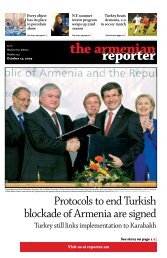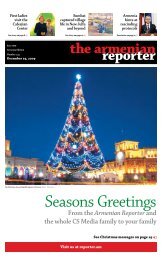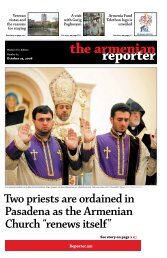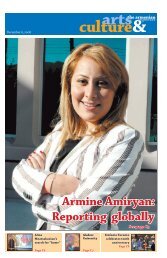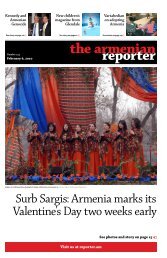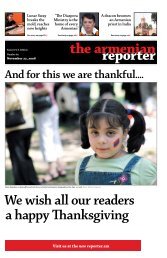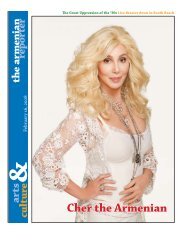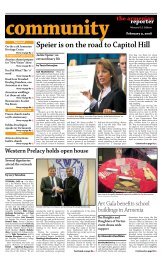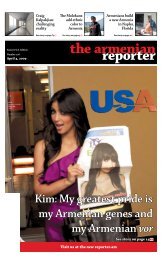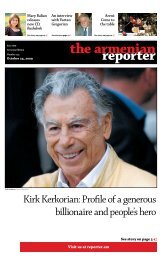Leading lady Karen Kondazian - Armenian Reporter
Leading lady Karen Kondazian - Armenian Reporter
Leading lady Karen Kondazian - Armenian Reporter
You also want an ePaper? Increase the reach of your titles
YUMPU automatically turns print PDFs into web optimized ePapers that Google loves.
An Earthworks<br />
collage of earth,<br />
straw, and a<br />
worn soil sifter.<br />
The artisan<br />
tool creates a<br />
context that adds<br />
an additional<br />
dimension of<br />
laborious human<br />
effort in a bleak<br />
landscape.<br />
daughter Sabrina, he packed up,<br />
disposed of his chic art gallery,<br />
and came to Armenia, the home<br />
of his dreams and his heart.<br />
Armenia had just declared its<br />
independence from the Soviet<br />
Union and had entered the extraordinarily<br />
difficult period of<br />
drastic social adjustments, contentious<br />
relations with neighbors,<br />
armed conflict, and the ongoing<br />
blockade of its east and west borders,<br />
while it tried to reorient and<br />
build a sustainable market economy.<br />
It was at this time he donated<br />
this collection in the name of his<br />
daughter to Armenia. Seeking a<br />
place to house it, the economically<br />
hard-pressed government in<br />
1993 found space in the Art and<br />
Literature wing of the <strong>Armenian</strong><br />
National Galleries, where it has<br />
since remained pending other<br />
outcomes.<br />
After all these years it still looks<br />
like the temporary exhibition of<br />
two museums in a large closet.<br />
Earthworks<br />
In my judgment the visible Marcos<br />
Grigorian legacy is his Earthworks.<br />
They may be understood as<br />
part of the Abstract Impressionist<br />
movement to which Arshile Gorky<br />
gave birth. But I relate them to<br />
his grappling with the theme of<br />
the <strong>Armenian</strong> Genocide and the<br />
issues related to the question: To<br />
whom does the crust of our earth<br />
belong and what promise of home<br />
can we make to the newborn?<br />
His Earthworks occurred when<br />
he put down his brushes and canvas<br />
and no longer painted. He<br />
went back to the earth, plunged in<br />
his hands, clasped them as claws<br />
in the mud, and pulled out in his<br />
touch intimations of his own mortality<br />
but the ultimate immortality<br />
of mankind.<br />
His Earthworks gain resonance<br />
when seen in the context of their<br />
complementarities with, and perhaps<br />
their influence on, the conceptual<br />
thinking of specific other<br />
artists. The actual subjects may<br />
seem far removed, but the same<br />
elemental approach has resulted<br />
in works that, in my judgment, are<br />
related and of astounding beauty.<br />
One such artist is Parviz Tanovoli<br />
and his sculptures of a nightingale<br />
emerging from a cage and its cry<br />
into the void – the heech, the vast<br />
nothingness that holds the shadow<br />
of God. Another is Sirak Melconian,<br />
who looks beneath the skin<br />
of the earth to the tensions in the<br />
tectonic plates, and we can feel in<br />
our own belly the unseen knots of<br />
grinding care and sometimes the<br />
fragile equilibriums in our swollen<br />
hearts. This is the company where<br />
his work ultimately belongs and<br />
its significance is revealed.<br />
The rest of the work, with few<br />
exceptions, is like a large orchestra<br />
tuning up for the performance<br />
at a later hour.<br />
Auschwitz<br />
At the museum his work is shown<br />
as going through three phases. In<br />
the first he returns to Iran from<br />
studies in Europe, holding a diploma<br />
from the Academy of Fine Arts<br />
in Rome. This phase is covered by<br />
the first canvases in the collection,<br />
the young artist in color bursts of<br />
paint that establish his bona fides<br />
as a relatively conventional artist<br />
who can paint recognizable faces<br />
if he wants to. It is followed by a<br />
second phase, which flirts on the<br />
edge of the Picasso of the Demoiselles<br />
d’Avignon.<br />
This second phase culminates in<br />
a massive, signature work on Auschwitz.<br />
With international attention<br />
riveted on the Holocaust, he<br />
declares, “My cry has now become<br />
the world’s cry,” and he attempts<br />
to depict the horrors of the mass<br />
murder of innocents in paint.<br />
It is a project of overarching<br />
ambition with dubious prospects<br />
from the start.<br />
To paint an ultimate horror that<br />
will not drive you away in revulsion,<br />
that will instead draw you<br />
to the canvas, engage your mind,<br />
and have you come away with a<br />
sense of witness: that would be<br />
profoundly difficult. I would be in<br />
awe if it could be done in paint.<br />
But to attempt to go further,<br />
which to my mind the theme of<br />
Genocide and Auschwitz demands,<br />
to create a shared experience in living<br />
time not as a mere happening<br />
but as a shattering convulsion in<br />
the body of humanity: that would<br />
be virtually impossible. Media<br />
other than canvas and paint may<br />
offer possibilities, but even then<br />
within the culture, and within the<br />
body politic, a profound feeling<br />
for the event to be depicted must<br />
already exist.<br />
If events have not already<br />
moved you to outrage, a daub of<br />
paint will not.<br />
However, if such a feeling already<br />
exists, very little is needed<br />
to create powerful responses.<br />
Here in Yerevan in the park at the<br />
corner of Terian and Moscovian,<br />
just off the pedestrian walk, there<br />
is an upright stone with some<br />
words inscribed. Into a split near<br />
the top of the single stone is a burnished<br />
brass object in the shape<br />
C6 <strong>Armenian</strong> <strong>Reporter</strong> Arts & Culture 10/20/2007



